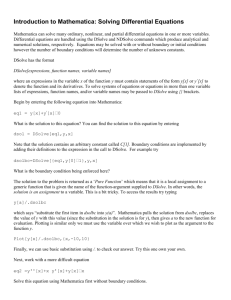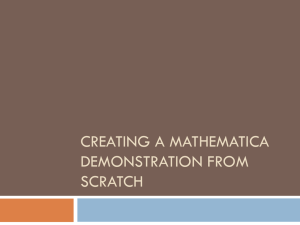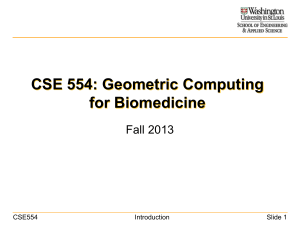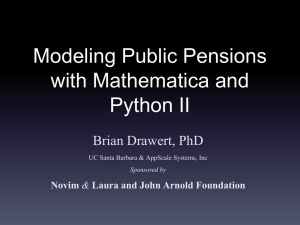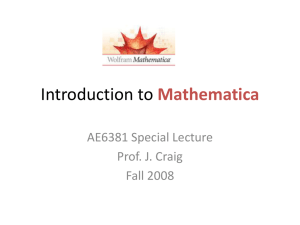Solving ODEs with Mathematica
advertisement
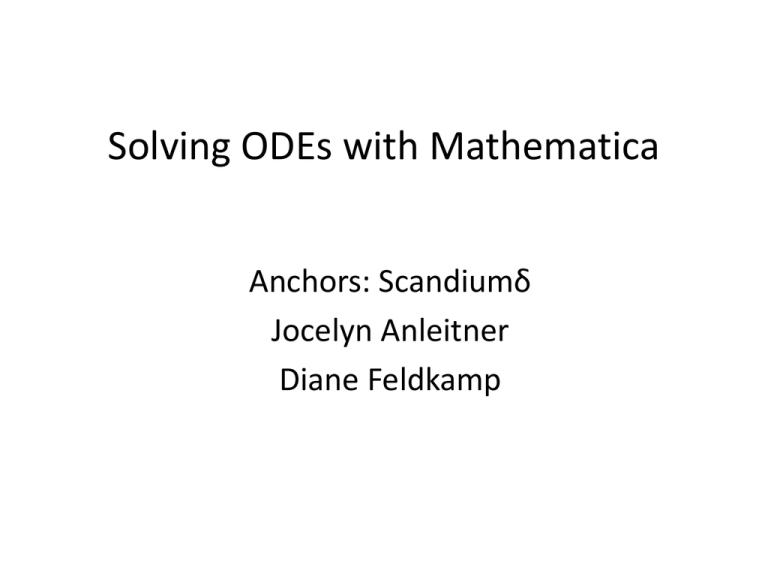
Solving ODEs with Mathematica
Anchors: Scandiumδ
Jocelyn Anleitner
Diane Feldkamp
Mathematica Basics
Purpose: Mathematica solves difficult
mathematical formulas
Focus: solving ordinary differential equations
(ODEs) of 1st and higher order using
Mathematica
dy
1st Order ODE:
f ( x, y )
dx
dzx
Higher Order ODE:
f ( x, y )
z
dy
Mathematica Syntax
Details about important syntax for
Mathematica can be reviewed on the wiki
page titled “Solving ODEs with Mathematica”
For entering ODEs, use double equal signs (==)
to define the functions
When finished with a line, use “Shift”+
“Enter” for Mathematica to compute the
answer
Dsolve and NDSolve
For ODEs without initial conditions, use Dsolve
Type of Equation
Syntax
Example Equation(s)
Dsolve for Example
One ODE
Dsolve[eqn,y,x]
y''+16y=0
Dsolve[y''[x]+16y[x]==0,y,x]
Multiple ODEs
Dsolve[{eqn1,eqn2,…},{y1,y2,…},x]
y1'-y2-x=0
y2'-y1-1=0
Dsolve[{y1'[x]-y2[x]-x==0,y2'[x]-y1[x]1==0},{y1,y2},x]
For ODEs with initial conditions, use NDSolve
Type of Equation
Syntax
Example Equation(s)
Dsolve for Example
One ODE
NDSolve[{eqn,i1,i2…},y,{x,xmin,xma
x}]
y''+16y=0,y(0)=1,
y'(0)=0
NDSolve[{y''[x]+16y==0,y[0]==1,y'[0]==0},y,{x,
0,30}]
Multiple ODEs
NDSolve[{eqn1, eqn2, ..., i1, i2,
…},{y1,y2},{x,xmin,xmax}]
y1'-y2-x=0
y2'-y1-1=0
y1(0)=0,y2(0)=0
NDSolve[{y1'[x]-y2[x]-x==0,y2'[x]-y1[x]1==0,y1[0]==y2[0]==0},{y1,y2},{x,20}]
Example: Semi-batch Reactor
(Worked Out Example 2)
Reaction: AB
Rate Law: rA
Mole Balance:
Given Variables:
k 2.7
kC A
1 CB
rV
dX
A
dt
N A0
N (1-X)
Stoichiometry: C A = A0
V0 0t
CB =
N A0 X
V0 + 0
k(1-X)(V0 + 0 t)
dX
Combine:
=
dt
N A0 X
V0 5
0 0.05
N A0 2500
X0 0
First-order ODE with Initial
Conditions
Use NDSolve in Mathematica
Entering in Mathematica
Open Mathematica (Version shown here is Mathematica 6)
Use the following steps to solve the ODE in Mathematica:
1.
Input ODE
2.
Define given variables
Entering in Mathematica (cont.)
3.
Define a variable to NDSolve and enter inputs
X is conversion, and X[0] is entered as 0.0001 instead
of 0 so that the ODE will not be undefined
4.
Plot the solution
Sources
Solving ODEs with Mathematica (wiki):
http://controls.engin.umich.edu/wiki/index.php
/Solving_ODEs_with_Mathematica
